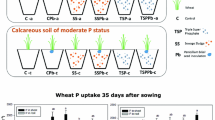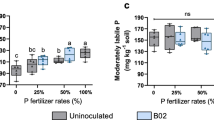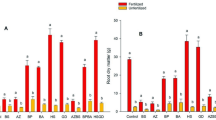Abstract
With P being a non-renewable resource, the use of microbial inoculants and waste products for more efficient and sustainable P use in plant production has been proposed. We investigated the ability of Penicillium bilaii to mobilize P in a low-fertility soil with or without amendment of sewage sludge as additional P source. Maize was grown for 27 days in rhizoboxes enabling studies of root growth in addition to plant and soil parameters. P. bilaii was inoculated either at the seed or the sewage sludge patch. At early growth stages, P. bilaii inoculation of seeds increased maize shoot length. However, at the end of experiment, the effect had ceased. Root growth was increased by seed P. bilaii inoculation alone and in combination with sewage sludge, whereas patch inoculation was less effective. Colonization studies performed at harvest showed that P. bilaii could not be detected in the maize rhizosphere but stayed at the place of inoculation. In sewage sludge patches, the growth of Penicillium strains other than P. bilaii was stimulated; hence, using sewage sludge for combined P resource and carrier of microbial inoculants is discussed. Unexpectedly, the greater root development of seed-inoculated plants did not result in increased plant P uptake and neither did inoculation at the sewage sludge patch. This study raises the question if the soil P status can be too low for a beneficial effect of additional early root growth and thus a beneficial effect of seed inoculation of P. bilaii.







Similar content being viewed by others
References
Asea PEA, Kucey RMN, Stewart JWB (1988) Inorganic phosphate solubilization by two Penicillium species in solution culture and soil. Soil Biol Biochem 20:459–464
Barea JM, Toro M, Orozco MO, Campos E, Azcon R (2002) The application of isotopic 32P and 15N-dilution techniques to evaluate the interactive effect of phosphate-solubilizing rhizobacteria, mycorrhizal fungi, and Rhizobium to improve the agronomic efficiency of rock phosphate for legume crops. Nutr Cycl Agroecosys 63:35–42
Bashan Y, Kamnev A, de-Bashan L (2013) Tricalcium phosphate is inappropriate as a universal selection factor for isolating and testing phosphate-solubilizing bacteria that enhance plant growth: a proposal for an alternative procedure. Biol Fertil Soils 49:465–479
Bashan Y, Kloepper JW, de-Bashan LE, Nannipieri P (2016) A need for disclosure of the identity of microorganisms, constituents, and application methods when reporting tests with microbe-based or pesticide-based products. Biol Fertil Soils 52:283–284
Beckie HJ, Schlechte D, Moulin AP, Gleddie SC, Pulkinen DA (1998) Response of alfalfa to inoculation with Penicillium bilaiae (provide). Can J Plant Sci 78:91–102
Bramley H, Tyerman SD, Turner DW, Turner NC (2011) Root growth of lupins is more sensitive to waterlogging than wheat. Funct Plant Biol 38:910–918
Chang AC, Page AL, Sutherland FH, Grgurevic E (1983) Fractionation of phosphorus in sludge affected soils. J Environ Qual 12:286–290
Childers DL, Corman J, Edwards M, Elser JJ (2011) Sustainability challenges of phosphorus and food: solutions from closing the human phosphorus cycle. Bioscience 61:117–124
Cunningham JE, Kuiack C (1992) Production of citric and oxalic acids and solubilization of calcium phosphate by Penicillium bilaiae. Appl Environ Microb 58:1451–1458
de-Bashan LE, Bashan Y (2004) Recent advances in removing phosphorus from wastewater and its use as fertilizer (1997–2003). Water Res 38:222–4246
Downey J, van Kessel CH (1990) Dual inoculation of Pisum sativum with Rhizobium leguminosarum and Penicillium bilaiae. Biol Fert Soils 10:194–196
Frossard E, Sinaj S, Zhang LM, Morel JL (1996) The fate of sludge phosphorus in soil–plant systems. Soil Sci Soc Am J 60:1248–1253
Gahoonia TS, Nielsen NE (1997) Variation in root hairs of barley cultivars doubled soil phosphorus uptake. Plant Soil 98:177–182
Ge Z, Rubio G, Lynch JP (2000) The importance of root gravitropism for inter–root competition and phosphorus acquisition efficiency: results from a geometric simulation model. Plant Soil 218:159–171
George TS, Gregorya PJ, Wooda M, Reada D, Bureshb RJ (2002) Phosphatase activity and organic acids in the rhizosphere of potential agroforestry species and maize. Soil Biol Biochem 34:1487–1494
Gulden RH, Vessey JK (2000) Penicillium bilaiae inoculation increases root–hair production in field pea. Can J Plant Sci 80:801–804
Hammond JP, Broadley MR, White PJ, King GJ, Bowen HC, Hayden R, Meacham MC, Mead A, Overs T, Spracklen WP, Greenwood DJ (2009) Shoot yield drives phosphorus use efficiency in Brassica oleracea and correlates with root architecture traits. J Exp Bot 60:1953–1968
Harrison MJ (1997) The arbuscular mycorrhizal symbiosis: an underground association. Trends Plant Sci 2:54–60
Jakobsen I, Leggett ME, Richardson AE (2005) Rhizosphere microorganisms and plant phosphorus uptake. In: Sims JT, Sharpley AN (eds) Phosphorus agriculture and the environment. American Society for Agronomy, Madison, pp 437–494
Jones JB, Wolf B, Mills HA (1991) Plant analysis handbook. Micro–Macro Publishing, Athens, p 213
JumpStart, 2016. http://www.monsantobioag.com/global/us/Products/Documents/Labels/JumpStart_WP_AllCrop_Label.pdf
Karamanos RE, Flore NA, Harapiak JT (2010) Re–visiting use of Penicillium bilaiae with phosphorus fertilization of hard red spring wheat. Can J Plant Sci 90:265–277
Kucey RMN (1983) Phosphate–solubilizing bacteria and fungi in various cultivated and virgin Alberta soils. Can J Soil Sci 63:671–678
Kucey RMN (1987) Increased phosphorus uptake by wheat and field beans inoculated with a phosphorus–solubilizing Penicillium bilaji strain and with vesicular–arbuscular mycorrhizal fungi. Appl Environ Microb 53:2699–2703
Kucey RMN (1988) Effect of Penicillium bilaiae on the solubility and uptake of P and micronutrients from soil by wheat. Can J Soil Sci 68:261–270
Kucey RMN, Leggett ME (1989) Increased yields and phosphorus uptake by westar canola (Brassica napus L) inoculated with a phosphate–solubilizing isolate of Penicillium bilaji. Can J Soil Sci 69:425–432
Kucey RMN, Janzen HH, Leggett ME (1989) Microbially mediated increases in plant-available phosphorus. Adv Agron 42:199–228
Leggett M, Newlands NK, Greenshields D, West L, Inman S, Koivunen ME (2015) Maize yield response to a phosphorus–solubilizing microbial inoculant in field trials. J Agr Sci 153:1464–1478
Ma QH, Zhang FS, Rengel Z, Shen JB (2013) Localized application of NH4 +–N plus P at the seedling and later growth stages enhances nutrient uptake and maize yield by inducing lateral root proliferation. Plant Soil 372:65–80
Mollier A, Pellerin S (1999) Maize root system growth and development as influenced by phosphorus deficiency. J Exp Bot 50:487–497
Nicolaisen MH, Bælum J, Jacobsen CS, Sørensen J (2008) Transcription dynamics of the functional tfdA gene during MCPA herbicide degradation by Cupriavidus necator AEO106 (pRO101) in agricultural soil. Environ Microbiol 10:571–579
Paulin M, Nicolaisen MH, Jacobsen CS, Gimsing AL, Sørensen J, Bælum J (2013) Improving Griffith’s protocol for co–extraction of microbial DNA and RNA in adsorptive soils. Soil Biol Biochem 63:37–49
Pierzynski GM, Gehl KA (2005) Plant nutrient issues for sustainable land application. J Environ Qual 34:18–28
Pii Y, Mimmo T, Tomasi N, Terzano R, Cesco S, Crecchio C (2015) Microbial interactions in the rhizosphere: beneficial influences of plant growth-promoting rhizobacteria on nutrient acquisition process. A review. Biol Fert Foils 51:403–415
Postma JA, Dathe A, Lynch JP (2014) The optimal lateral root branching density for maize depends on nitrogen and phosphorus availability. Plant Physiol 166:590–602
Richardson AE (2001) Prospects for using soil microorganisms to improve the acquisition of phosphorus by plants. Aust J Plant Physiol 28:897–906
Richardson AE, Barea JM, Mcneill AM, Prigent-Combaret C (2009) Acquisition of phosphorus and nitrogen in the rhizosphere and plant growth promotion by microorganisms. Plant Soil 321:305–339
Rodriguez H, Fraga R, Gonzalez T, Bashan Y (2006) Genetics of phosphate solubilization and its potential applications for improving plant growth-promoting rhizobacteria. Plant Soil 287:15–21
Ryan PR, Delhaize E, Jones LD (2001) Function and mechanism of organic anion exudation from plant roots. Annu Revof Plant Phys 52:527–560
Schwartz C, Morrel JL, Saumier S, Whiting SN, Baker AJM (1999) Root development of the zinc-hyperaccumulator plant Thlaspi caerulesens as affected by metal origin, content and localization in soil. Plant Soil 208:103–115
Shen J, Yuan L, Zhang J, Li H, Bai Z, Chen X, Zhang W, Zhang F (2011) Phosphorus dynamics: from soil to plant. Plant Physiol 156:997–1005
Shen JB, Li CJ, Mi GH, Li L, Yuan LX, Jiang RF, Zhang FS (2013) Maximizing root/rhizosphere efficiency to improve crop productivity and nutrient use efficiency in intensive agriculture of China. J Exp Bot 64:1181–1192
Shober AL, Hesterberg DL, Sims JT, Gardner S (2006) Characterization of phosphorus species in biosolids and manures using XANES spectroscopy. J Environ Qual 35:1983–1993
Silverbush M, Barber SA (1983) Sensitivity of simulated phosphorus uptake to parameters used by mechanistic mathematical model. Plant Soil 74:93–100
Sommers LE (1977) Chemical composition of sewage sludge and analysis of their potential use as fertilizer. J Environ Qual 6:225–232
Tinker PB, Nye PH (2000) Solute movement in the rhizosphere, 2nd edn. Oxford University Press, New York
Van der Paauw F (1971) An effective water extraction method for the determination of plant–available soil phosphorus. Plan Soil 34:467–481
Vessey JK, Heisinger KG (2001) Effect of Penicillium bilaiae inoculation and phosphorus fertilization on root and shoot parameters of field–grown pea. Can J Plant Sci 31:361–366
Wakelin SA, Warren RA, Harvey PR, Ryder MH (2004) Phosphate solubilization by Penicillium spp closely associated with wheat roots. Biol Fert Soils 40:36–43
Walter I, Cuevas G, Garcia S, Martinez F (2000) Biosolid effects on soil and native plant production in a degraded semiarid ecosystem in central Spain. Waste Manage Res 18:259–263
Whitelaw MA (2000) Growth promotion of plants inoculated with phosphate–solubilizing fungi. Adv Agron 69:99–151
Wissuwa M (2003) How do plants achieve tolerance to phosphorus deficiency: small causes with big effects. Plant Physiol 133:1947–1958
Yadav RS, Tarafdar JC (2003) Phytase of fungi in arid and semi-arid soils and their efficiency in hydrolysing different organic P compounds. Soil Biol Biochem 35:1–7
Yadav BK, Tarafdar JC (2007) Ability of Emericella rugulosa to mobilize unavailable P compounds during pearl millet (Pennisetum glaucum L) crop under arid condition. Indian J Microbiol 41:57–63
Acknowledgments
The authors would like to thank to Lene Vigh, Lena Asta Byrgesen and Ayse Gül Özcetin for their support with the sample analysis. This study was supported by Innovationsfonden-Denmark (grant number 1308-00016B to the project “Microbial biofertilizers for enhanced crop availability of phosphorus pools in soil and waste, MiCroP”).
Author information
Authors and Affiliations
Corresponding author
Rights and permissions
About this article
Cite this article
Gómez-Muñoz, B., Pittroff, S.M., de Neergaard, A. et al. Penicillium bilaii effects on maize growth and P uptake from soil and localized sewage sludge in a rhizobox experiment. Biol Fertil Soils 53, 23–35 (2017). https://doi.org/10.1007/s00374-016-1149-x
Received:
Revised:
Accepted:
Published:
Issue Date:
DOI: https://doi.org/10.1007/s00374-016-1149-x




